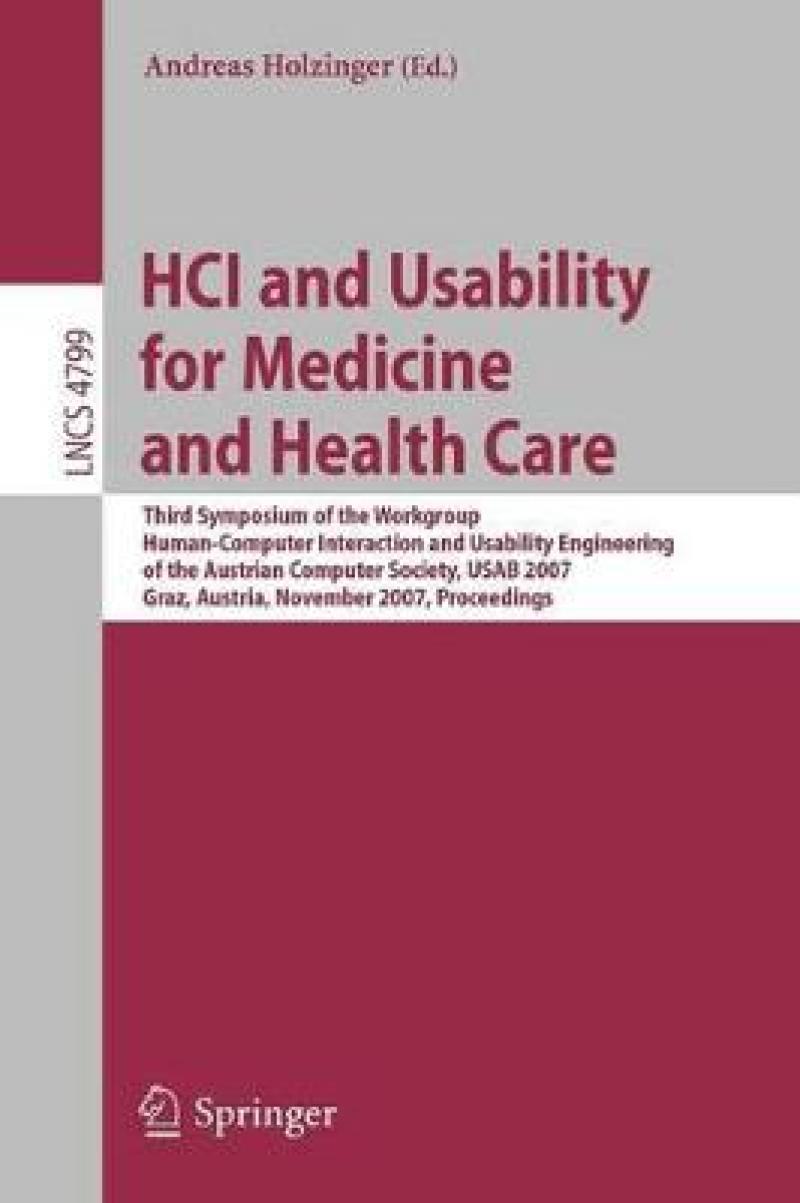The work group Human–Computer Interaction & Usability Engineering (HCI&UE) of the Austrian Computer Society (OCG) serves as a platform for interdisciplinary exchange, research and development. While human–computer interaction brings together psychologists and computer scientists, usability engineering is a discipline within software engineering. It is essential that psychology research must be incorporated into software engineering at a systemic level. The aspect of integration of human factors into informatics is especially important, since it is here that innovations take place, systems are built and applications are implemented. Our 2007 topic was “Human–Computer Interaction for Medicine and Health Care” (HCI4MED), culminating in the third annual Usability Symposium USAB 2007 on November 22, 2007 in Graz, Austria (http://www.meduni-graz.at/imi/usab-symposium). Medical information systems are already extremely sophisticated and technological performance increases exponentially. However, human cognitive evolution does not advance at the same speed. Consequently, the focus on interaction and communication between humans and computers is of increasing importance in medicine and health care. The daily actions of medical professionals must be the central concern, surrounding and supporting them with new and emerging technologies. Information systems are a central component of modern knowledge-based medicine and health services, therefore knowledge management needs to continually be adapted to the needs and demands of medical professionals within this environment of steadily increasing high-tech medicine. information processing, in particular its potential effectiveness in modern health services and the optimization of processes and operational sequences, is ofincreasing interest.
Les mer
Information systems are a central component of modern knowledge-based medicine and health services, therefore knowledge management needs to continually be adapted to the needs and demands of medical professionals within this environment of steadily increasing high-tech medicine.
Les mer
Formal Methods in Usability Engineering.- User-Centered Methods Are Insufficient for Safety Critical Systems.- Improving Interactive Systems Usability Using Formal Description Techniques: Application to HealthCare.- Using Formal Specification Techniques for Advanced Counseling Systems in Health Care.- System Analysis and Methodologies for Design and Development.- Nurses’ Working Practices: What Can We Learn for Designing Computerised Patient Record Systems?.- Organizational, Contextual and User-Centered Design in e-Health: Application in the Area of Telecardiology.- The Effect of New Standards on the Global Movement Toward Usable Medical Devices.- Usability of Radio-Frequency Devices in Surgery.- BadIdeas for Usability and Design of Medicine and Healthcare Sensors.- Physicians’ and Nurses’ Documenting Practices and Implications for Electronic Patient Record Design.- Ambient Assisted Living and Life Long Learning.- Design and Development of a Mobile Medical Application for the Management of Chronic Diseases: Methods of Improved Data Input for Older People.- Technology in Old Age from a Psychological Point of View.- Movement Coordination in Applied Human-Human and Human-Robot Interaction.- An Orientation Service for Dependent People Based on an Open Service Architecture.- Competence Assessment for Spinal Anaesthesia.- Visualization and Simulation in Medicine and Health Care.- Usability and Transferability of a Visualization Methodology for Medical Data.- Refining the Usability Engineering Toolbox: Lessons Learned from a User Study on a Visualization Tool.- Interactive Analysis and Visualization of Macromolecular Interfaces between Proteins.- Modeling Elastic Vessels with the LBGK Method in Three Dimensions.- Usability of Mobile Computing and Augmented Reality.-Usability of Mobile Computing Technologies to Assist Cancer Patients.- Usability of Mobile Computing in Emergency Response Systems – Lessons Learned and Future Directions.- Some Usability Issues of Augmented and Mixed Reality for e-Health Applications in the Medical Domain.- Designing Pervasive Brain-Computer Interfaces.- Medical Expert Systems and Decision Support.- The Impact of Structuring the Interface as a Decision Tree in a Treatment Decision Support Tool.- Dynamic Simulation of Medical Diagnosis: Learning in the Medical Decision Making and Learning Environment MEDIC.- SmartTransplantation - Allogeneic Stem Cell Transplantation as a Model for a Medical Expert System.- Framing, Patient Characteristics, and Treatment Selection in Medical Decision-Making.- The How and Why of Incident Investigation: Implications for Health Information Technology.- Research Methodologies, Cognitive Analysis and Clinical Applications.- Combining Virtual Reality and Functional Magnetic Resonance Imaging (fMRI): Problems and Solutions.- Cognitive Task Analysis for Prospective Usability Evaluation in Computer-Assisted Surgery.- Serious Games Can Support Psychotherapy of Children and Adolescents.- Development and Application of Facial Expression Training System.- Usability of an Evidence-Based Practice Website on a Pediatric Neuroscience Unit.- Ontologies, Semantics, Usability and Cognitive Load.- Cognitive Load Research and Semantic Apprehension of Graphical Linguistics.- An Ontology Approach for Classification of Abnormal White Matter in Patients with Multiple Sclerosis.- The Evaluation of Semantic Tools to Support Physicians in the Extraction of Diagnosis Codes.- Ontology Usability Via a Visualization Tool for the Semantic Indexing of Medical Reports (DICOM SR).- Agile Methodologies,Analytical Methods and Remote Usability Testing.- Fostering Creativity Thinking in Agile Software Development.- An Analytical Approach for Predicting and Identifying Use Error and Usability Problem.- User’s Expertise Differences When Interacting with Simple Medical User Interfaces.- Usability-Testing Healthcare Software with Nursing Informatics Students in Distance Education: A Case Study.- Tutorial: Introduction to Visual Analytics.
Les mer
GPSR Compliance
The European Union's (EU) General Product Safety Regulation (GPSR) is a set of rules that requires consumer products to be safe and our obligations to ensure this.
If you have any concerns about our products you can contact us on ProductSafety@springernature.com.
In case Publisher is established outside the EU, the EU authorized representative is:
Springer Nature Customer Service Center GmbH
Europaplatz 3
69115 Heidelberg, Germany
ProductSafety@springernature.com
Les mer
Produktdetaljer
ISBN
9783540768043
Publisert
2007-11-12
Utgiver
Springer-Verlag Berlin and Heidelberg GmbH & Co. KG; Springer-Verlag Berlin and Heidelberg GmbH & Co. K
Høyde
235 mm
Bredde
155 mm
Aldersnivå
Research, P, 06
Språk
Product language
Engelsk
Format
Product format
Heftet
Redaktør

